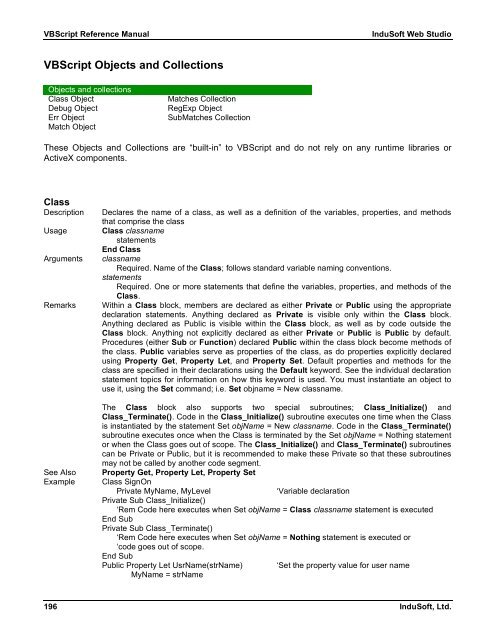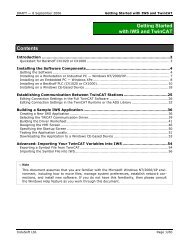VBScript Reference Manual for InduSoft Web Studio
VBScript Reference Manual for InduSoft Web Studio
VBScript Reference Manual for InduSoft Web Studio
Create successful ePaper yourself
Turn your PDF publications into a flip-book with our unique Google optimized e-Paper software.
<strong>VBScript</strong> <strong>Reference</strong> <strong>Manual</strong> <strong>InduSoft</strong> <strong>Web</strong> <strong>Studio</strong><br />
<strong>VBScript</strong> Objects and Collections<br />
Objects and collections<br />
Class Object Matches Collection<br />
Debug Object RegExp Object<br />
Err Object SubMatches Collection<br />
Match Object<br />
These Objects and Collections are “built-in” to <strong>VBScript</strong> and do not rely on any runtime libraries or<br />
ActiveX components.<br />
Class<br />
Description Declares the name of a class, as well as a definition of the variables, properties, and methods<br />
that comprise the class<br />
Usage Class classname<br />
statements<br />
End Class<br />
Arguments classname<br />
Required. Name of the Class; follows standard variable naming conventions.<br />
statements<br />
Required. One or more statements that define the variables, properties, and methods of the<br />
Class.<br />
Remarks Within a Class block, members are declared as either Private or Public using the appropriate<br />
declaration statements. Anything declared as Private is visible only within the Class block.<br />
Anything declared as Public is visible within the Class block, as well as by code outside the<br />
Class block. Anything not explicitly declared as either Private or Public is Public by default.<br />
Procedures (either Sub or Function) declared Public within the class block become methods of<br />
the class. Public variables serve as properties of the class, as do properties explicitly declared<br />
using Property Get, Property Let, and Property Set. Default properties and methods <strong>for</strong> the<br />
class are specified in their declarations using the Default keyword. See the individual declaration<br />
statement topics <strong>for</strong> in<strong>for</strong>mation on how this keyword is used. You must instantiate an object to<br />
use it, using the Set command; i.e. Set objname = New classname.<br />
The Class block also supports two special subroutines; Class_Initialize() and<br />
Class_Terminate(). Code in the Class_Initialize() subroutine executes one time when the Class<br />
is instantiated by the statement Set objName = New classname. Code in the Class_Terminate()<br />
subroutine executes once when the Class is terminated by the Set objName = Nothing statement<br />
or when the Class goes out of scope. The Class_Initialize() and Class_Terminate() subroutines<br />
can be Private or Public, but it is recommended to make these Private so that these subroutines<br />
may not be called by another code segment.<br />
See Also Property Get, Property Let, Property Set<br />
Example Class SignOn<br />
Private MyName, MyLevel ‘Variable declaration<br />
Private Sub Class_Initialize()<br />
‘Rem Code here executes when Set objName = Class classname statement is executed<br />
End Sub<br />
Private Sub Class_Terminate()<br />
‘Rem Code here executes when Set objName = Nothing statement is executed or<br />
‘code goes out of scope.<br />
End Sub<br />
Public Property Let UsrName(strName) ‘Set the property value <strong>for</strong> user name<br />
MyName = strName<br />
196 <strong>InduSoft</strong>, Ltd.



